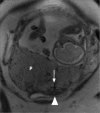The morbidly adherent placenta: when and what association of signs can improve MRI diagnosis? Our experience
- PMID: 28360021
- PMCID: PMC5410997
- DOI: 10.5152/dir.2017.16275
The morbidly adherent placenta: when and what association of signs can improve MRI diagnosis? Our experience
Abstract
Purpose: We aimed to verify whether combination of specific signs improves magnetic resonance imaging (MRI) accuracy in morbidly adherent placenta (MAP).
Methods: MRI findings for MAP were retrospectively evaluated in 27 women. Histopathology was the reference standard, showing MAP in eight of 27 cases. Specificity, sensitivity, positive predictive value, and negative predictive value were calculated for all MRI signs. Two skilled radiologists analyzed MRI findings, resolving discrepancies by consensus, using three alternative diagnostic criteria during three consecutive sections. First criterion: at least one of reported MRI signs indicates MAP and the absence of any sign is normal; second criterion: at least one statistically significant sign indicates MAP and no sign or nonsignificant sign is normal; third criterion: at least two statistically significant signs indicate MAP and no sign, nonsignificant sign, or only one significant sign is normal.
Results: Using the first criterion yielded an unacceptable rate of false positive results (78.9%). Using the second criterion there were less false positive results (31.5%), and diagnostic accuracy of the second criterion was significantly higher than the first; the third criterion correctly classified 100% of cases.
Conclusion: Only specific MRI signs can correctly predict MAP at histopathology, particularly when multiple (at least two) specific signs are observed together.
Conflict of interest statement
The authors declared no conflicts of interest.
Figures





Similar articles
-
Diagnostic accuracy of magnetic resonance imaging in assessing placental adhesion disorder in patients with placenta previa: Correlation with histological findings.Eur J Radiol. 2018 Sep;106:77-84. doi: 10.1016/j.ejrad.2018.07.014. Epub 2018 Jul 19. Eur J Radiol. 2018. PMID: 30150055
-
Clinical Utility of the Prenatal Ultrasound Score of the Placenta Combined with Magnetic Resonance Imaging in Diagnosis of Placenta Accreta during the Second and Third Trimester of Pregnancy.Contrast Media Mol Imaging. 2022 Jun 15;2022:9462139. doi: 10.1155/2022/9462139. eCollection 2022. Contrast Media Mol Imaging. 2022. PMID: 35821890 Free PMC article.
-
Accuracy of ultrasonography and magnetic resonance imaging in the diagnosis of placenta accreta.Obstet Gynecol. 2006 Sep;108(3 Pt 1):573-81. doi: 10.1097/01.AOG.0000233155.62906.6d. Obstet Gynecol. 2006. PMID: 16946217
-
Morbidly adherent placenta.Semin Perinatol. 2013 Oct;37(5):359-64. doi: 10.1053/j.semperi.2013.06.014. Semin Perinatol. 2013. PMID: 24176160 Review.
-
Cesarean scar pregnancy and early placenta accreta share common histology.Ultrasound Obstet Gynecol. 2014 Apr;43(4):383-95. doi: 10.1002/uog.13282. Ultrasound Obstet Gynecol. 2014. PMID: 24357257 Review.
Cited by
-
Same-sex parenting according to the Italian Constitutional Court: the need for legislative solutions.Acta Biomed. 2022 Jan 19;92(6):e2021496. doi: 10.23750/abm.v92i6.12431. Acta Biomed. 2022. PMID: 35075057 Free PMC article.
-
Society of Abdominal Radiology (SAR) and European Society of Urogenital Radiology (ESUR) joint consensus statement for MR imaging of placenta accreta spectrum disorders.Eur Radiol. 2020 May;30(5):2604-2615. doi: 10.1007/s00330-019-06617-7. Epub 2020 Feb 10. Eur Radiol. 2020. PMID: 32040730
-
Prediction of placenta accreta spectrum in patients with placenta previa using clinical risk factors, ultrasound and magnetic resonance imaging findings.Radiol Med. 2021 Sep;126(9):1216-1225. doi: 10.1007/s11547-021-01348-6. Epub 2021 Jun 22. Radiol Med. 2021. PMID: 34156592
-
Outcomes of prophylactic abdominal aortic balloon occlusion in patients with placenta previa accreta: a propensity score matching analysis.BMC Pregnancy Childbirth. 2022 Jun 20;22(1):502. doi: 10.1186/s12884-022-04837-2. BMC Pregnancy Childbirth. 2022. PMID: 35725388 Free PMC article.
-
A retrospective analysis of the treatment on abdominal aortic balloon occlusion-related thrombosis by continuous low-flow diluted heparin.Medicine (Baltimore). 2019 Dec;98(51):e18446. doi: 10.1097/MD.0000000000018446. Medicine (Baltimore). 2019. PMID: 31861017 Free PMC article.
References
-
- Lim BH, Palacios-Jaraquemada JM. The morbidly adherent placenta, a continuing diagnostic and management challenge. BJOG. 2015;122:1673. https://doi.org/10.1111/1471-0528.13561. - DOI - PubMed
-
- Elsayes KM, Trout AT, Friedkin AM, et al. Imaging of the placenta: a multimodality pictorial review. Radiographics. 2009;29:1371–1391. https://doi.org/10.1148/rg.295085242. - DOI - PubMed
-
- Derman AY, Nikac V, Haberman S, Zelenko N, Opsha O, Flyer M. MRI of placenta accreta: a new imaging perspective. AJR Am J Roentgenol. 2011;197:1514–1521. https://doi.org/10.2214/AJR.10.5443. - DOI - PubMed
-
- Leyendecker JR, DuBose M, Hosseinzadeh K, et al. MRI of pregnancy-related issues: abnormal placentation. AJR Am J Roentgenol. 2012;198:311–320. https://doi.org/10.2214/AJR.11.7957. - DOI - PubMed
-
- Algebally AM, Yousef RR, Badr SS, Al Obeidly A, Szmigielski W, Al Ibrahim AA. The value of ultrasound and magnetic resonance imaging in diagnostics and prediction of morbidity in cases of placenta previa with abnormal placentation. Pol J Radiol. 2014;79:409–716. https://doi.org/10.12659/PJR.891252. - DOI - PMC - PubMed
MeSH terms
LinkOut - more resources
Full Text Sources
Other Literature Sources
Medical

